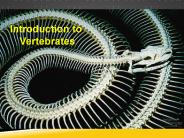Craniates PowerPoint PPT Presentations
All Time
Recommended
The parade of the Craniates Part 1 Major synapomorphies of the Craniates Developmental Neural crest Neurogenic placodes Nervous System Above Braincase (skeletal ...
| PowerPoint PPT presentation | free to download
Include Jawless ostacoderms and Hyperoartia (Lamprey) Most part of a Superclass Gnathostomata ... Lamprey (agnathas) Marine and freshwater. Prey on other fish ...
| PowerPoint PPT presentation | free to download
... further reduction of the jugal in Archosauria (crocs and birds) and Lepidosauria results in a single temporal opening. (A fourth pattern, euryapsid, ...
| PowerPoint PPT presentation | free to download
Figure 34.2 Echinodermata Cephalochordata ANCESTRAL DEUTEROSTOME Chordates Urochordata Notochord Myxini Craniates Common ancestor of chordates Petromyzontida
| PowerPoint PPT presentation | free to view
The Axial Skeleton Even craniates may have an exoskeleton and an endoskeleton Which type is derived from dermis and epidermis? Some bones have left their original ...
| PowerPoint PPT presentation | free to view
koalas. Tubulidentata. Aardvark. Hyracoidea. Hyraxes ... Koala. Vertebrates (Ch.34) Chordates. Craniates. Vertebrates. Gnathostomes. Tetrapods. Amniotes ...
| PowerPoint PPT presentation | free to view
Chordates and craniates; Vertebrates; Gnathostomes; Tetrapods, Amniotes, Mammals. ... Mammals ... Mammals. Figure 34.10 A lamprey - an example of a basal vertebrate. ...
| PowerPoint PPT presentation | free to view
Chordates By Eduardo Alexander Becerra and Caleb Jennings Staurseth
| PowerPoint PPT presentation | free to download
The Chordata Chapter 34
| PowerPoint PPT presentation | free to download
Chapter 34 The Origin and Evolution of Vertebrates
| PowerPoint PPT presentation | free to view
None gastrovascular cavity complete digestive system. Body cavities ... Larval urochordate exhibiting paedogenesis* cephalochordate * Early sexual maturity. ...
| PowerPoint PPT presentation | free to download
See figure 3-6. Lamprey- Vertebrate Ectoparasites ... Weeland canal around Niagra falls ! Lamprey Control: Exploiting basic natural history ...
| PowerPoint PPT presentation | free to download
Trends in Animal Evolution Symmetry ... deuterostome Digestive system None gastrovascular cavity complete digestive system Body cavities acoelomate pseudocoelomate ...
| PowerPoint PPT presentation | free to download
... Order Urodela (b) Order Anura (c) Order Apoda Fig. 34-27 (a) Tuatara (Sphenodon punctatus) (c) Wagler s pit viper (Tropidolaemus wagleri) (b) ...
| PowerPoint PPT presentation | free to download
Title: LE 01-10b Author: System_70 Created Date: 12/12/2005 9:42:59 PM Document presentation format: On-screen Show (4:3) Company: PIT Other titles
| PowerPoint PPT presentation | free to download
Gnathostomes Vertebrates with jaws. Derived Characters Jaws Duplication of Hox genes: Gave rise to larger brains, enhancing smell and vision.
| PowerPoint PPT presentation | free to download
Protochordates include Urochordates = Tunicates = Sea squirts (See figure 2-2 in text) Underappreciated beauty of tunicates Notochord Dorsal hollow nerve cord Pharynx ...
| PowerPoint PPT presentation | free to download
Chapter 34: Phylum Chordata
| PowerPoint PPT presentation | free to download
Evolution of Vertebrates Chapter 19
| PowerPoint PPT presentation | free to view
Vertebrates Emily Reiss Josie Jacob-Dolan Tori Willbanks-Roos
| PowerPoint PPT presentation | free to view
Special Somatic Receptors Membranous Labyrinth Vertebrates have pair of fluid filled membranous labyrinths Filled with ... Assists in transport of sound Figure ...
| PowerPoint PPT presentation | free to view
Vertebrate Diversity Chapter 34 Senses: vision, but no color; olfaction; electrical senses * Chordate Phylogeny Phylum Chordata Bilaterian deuterostomes Derived ...
| PowerPoint PPT presentation | free to view
Vertebrates Linnea Kirby, Michelle Duffy, and Adrienne Vergith-Hill
| PowerPoint PPT presentation | free to view
Vertebrate Diversity Chapter 34 Senses: vision, but no color; olfaction; electrical senses * Chordate Phylogeny Phylum Chordata Bilaterian deuterostomes Derived ...
| PowerPoint PPT presentation | free to view
Introduction to Vertebrates
| PowerPoint PPT presentation | free to download
Lampreys (oldest living lineage of vertebrates) are a parasite in marine ... Lamprey cartilage is unlike most vertebrae in that it contains no collagen, it ...
| PowerPoint PPT presentation | free to view
Gastrulation cont.
| PowerPoint PPT presentation | free to view
Animals and Animal Diversity The Nitty-gritty! Note: There is no red on this powerpoint, all non-essentials were deleted from the notes. Just imagine that everything ...
| PowerPoint PPT presentation | free to view
Comparative Anatomy Vertebrate Phylogeny: Fishes Kardong Chapter s 2 & 3 Part 4 Vertebrate Classification Geological Eras of early vertebrates Paleozoic (oldest ...
| PowerPoint PPT presentation | free to view
Chordata: Urochordata and Cephalochordata Michelle Sit and Paul Riviere What is a Chordata Chordata are fishes, amphibians, reptiles, birds, mammals, tunicates ...
| PowerPoint PPT presentation | free to view
Certains tres vivants ont, dans leurs doigts, un pouce opposable aux autres ... Certains tres vivants ont, dans leurs doigts, un pouce opposable aux autres ...
| PowerPoint PPT presentation | free to download
Animal Evolution The Invertebrates
| PowerPoint PPT presentation | free to view
One of these types of animals gave rise to vertebrates, ... Gnathostomata is subdivided into Pisces with fins and Tetrapoda, usually with two pair of limbs. ...
| PowerPoint PPT presentation | free to view
Chapter 34 Vertebrates A. Invertebrate Chordates and the Origin of Vertebrates The vertebrates belong to one of the two major phyla in the Deuterostomia, the ...
| PowerPoint PPT presentation | free to view
III' Myxiniformes, Petromyzontiformes
| PowerPoint PPT presentation | free to view
The Fishes: Vertebrate Success in Water The Fishes: Vertebrate Success in Water Chapter 18 Chapter 18 Fish Intro website Sharks cannot detect organisms wrapped in ...
| PowerPoint PPT presentation | free to download
Comparative Anatomy Circulatory System Kardong Chapter 12 Part 13 Aortic Arch Summary Urodele Ductus caroticus Ductus arteriosus - dorsal segment of 6th arch Reptiles ...
| PowerPoint PPT presentation | free to view
Robert B' Page, James R' Monaghan, Amy K' Samuels, Jeramiah J' Smith, Christopher K' Beachy and S' R
| PowerPoint PPT presentation | free to view
1Department of Biology and Spinal Cord and Brain Injury ... Mammalia. Amniota. Lissamphibia. Tetrapoda. Osteichthyes. WHY SALAMANDER? --phylogenetic place ...
| PowerPoint PPT presentation | free to view
Sense Organs Monitor external & internal environment Somatic or visceral receptors Specific or general Special Somatic ... neuro/senses.htm#illusions ...
| PowerPoint PPT presentation | free to view
Human embryo (5 weeks) Notochord attachment site for muscles ... Platypus. P. Chordata. Mammalia. Monotremes. Echidna. P. Chordata. Mammalia. Marsupials ...
| PowerPoint PPT presentation | free to view
Origin and Diversification of the Vertebrates Vertebrate Characteristics Origin and Diversification of Vertebrates Echinoderms Hemichordata (Acorn Worms) Urochordata ...
| PowerPoint PPT presentation | free to download
Invertebrates (Ch.33) Sponges,;Cnidarians; Molluscs, Annelids; Nematodes; Arthropods ... most intelligent invertebrates. Squids are speedy carnivores. with ...
| PowerPoint PPT presentation | free to view
Biology 172 Chapter 34 Phylum Chordata Kingdom Animalia Phylum Chordata Kingdom Animalia Phylum Chordata Kingdom Animalia Phylum Chordata Chordate Characteristics ...
| PowerPoint PPT presentation | free to view
Lamprey- both pineal and parapineal are photosensitive. Lizard- parapineal ... Figure 16.16: Epiphyseal complex of lamprey and embryonic and adult lizard. ...
| PowerPoint PPT presentation | free to view
Vertebrates Lungfishes Classes of Chordates Tetrapods Classes of Tetrapods Amphibians Urodela ( tailed ones ) Salamanders Anura ( tailless ones ) Frogs and ...
| PowerPoint PPT presentation | free to download
Chordates Chapter 23 * * * * * * * * * * * * * * * * * * The Origin of Vertebrates Vertebrates evolved at least 530 million years ago, during the Cambrian explosion.
| PowerPoint PPT presentation | free to download
Christopher K' Beachy and S' Randal Voss
| PowerPoint PPT presentation | free to view
Introduction to the Invertebrates
| PowerPoint PPT presentation | free to view
Most bird communities or faunas are mosaics of species of various ages from various historical backgrounds ... (leaping or gliding) Vigilence Migration, etc ...
| PowerPoint PPT presentation | free to download
Monotremes 'Spiny Anteaters' (egg-laying) BIRDS & MAMMALS. Monotremes ... 5. Egg laying mammals ... The Tasmanian devil. the largest carnivorous ...
| PowerPoint PPT presentation | free to view
Animals are multicellular, heterotrophic eukaryotes with tissues ... Fig. 26.22 (we have used this several times before) ...
| PowerPoint PPT presentation | free to view
Sessile marine animals, 'Tadpole-like' larva -Pharynx enlarged ... Platypus and Spiny Anteater. Oviparous. Reptile-like Egg. Hair. Milk Produced by Specialized ...
| PowerPoint PPT presentation | free to view
Elasmobranchs - sharks (360 species in two major groups), skates and rays (450 species) ... Sharks as predators: locate prey in a geographic sense. detect prey ...
| PowerPoint PPT presentation | free to download
Title: N-Grams and Corpus Linguistics Author: Kathy McCoy Last modified by: Sudeshna Sarkar Created Date: 1/20/1999 7:57:44 PM Document presentation format
| PowerPoint PPT presentation | free to download
Comparative Anatomy Nervous System Note Set 12 Chapter 16 Primary Brain Vesicles Prosencephalon (Forebrain) Smell Mesoncephalon (Midbrain) Vision Rhombencephalon ...
| PowerPoint PPT presentation | free to view
























































